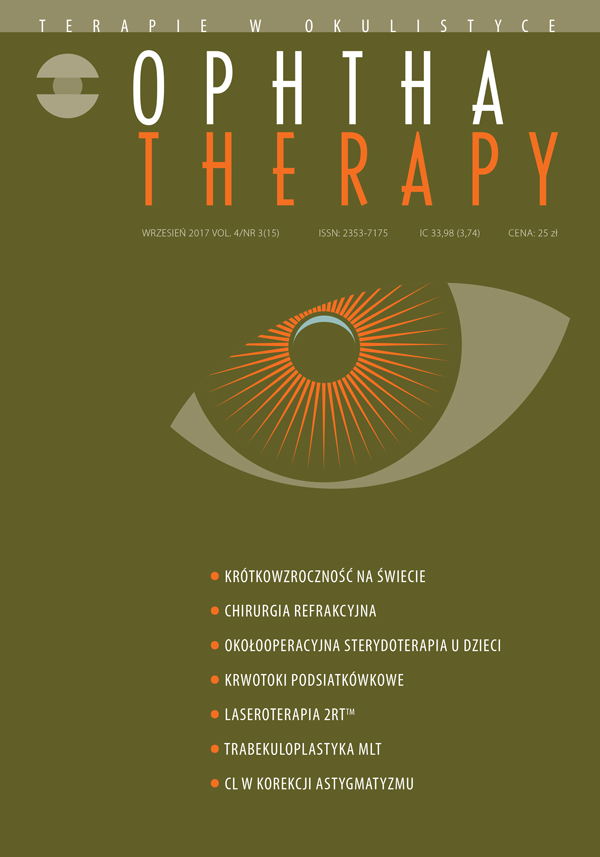Epidemiology and treatment of myopia worldwide
Main Article Content
Abstract
Nowadays, 1.6 billion people worldwide struggle with myopia; in 2050, half of the world's population will be impacted by the condition. Increased incidence of myopia, especially among children and youngsters, forces us to pay greater attention to the problem and look for solutions on how to prevent and treat the defect. Progressive myopia leads to such complications as glaucoma, cataract, retinal detachment or myopic macular degeneration related to myopia, all of which lead to a significant decrease in visual acuity. Myopia treatment methods can be divided into “traditional” and pharmacological. The best outcome may be achieved by dosing drops with atropine, and treatment effects last longest, if the concentration of 0.01% is used, causing the fewest side effects at the same time. Many widespread methods, such as undercorrected spectacles, do not bring effect
Downloads
Article Details

This work is licensed under a Creative Commons Attribution-NonCommercial-NoDerivatives 4.0 International License.
Copyright: © Medical Education sp. z o.o. License allowing third parties to copy and redistribute the material in any medium or format and to remix, transform, and build upon the material, provided the original work is properly cited and states its license.
Address reprint requests to: Medical Education, Marcin Kuźma (marcin.kuzma@mededu.pl)
References
2. Holden BA, Jong M, Davis S et al. Nearly 1 billion myopes at risk of myopia-related sight-threatening conditions by 2050 – time to act now. Clin Exp Optom. 2015; 98: 491-3.
3. Loughman J, Flitcroft DI. The acceptability and visual impact of 0,01% atropine in Caucasian population. Br J Ophthalmol. 2016; 100: 1525-9.
4. Janowski M, Bulte JWM, Handa JT et al. Concise Review: Using Stem Cells to Prevent the Progression of Myopia – A Concept. Stem Cells. 2015; 33: 2104-13.
5. Polling JR, Kok RGW, Tideman JWL et al. Effectiveness study of atropine for progressive myopia in Europeans. Eye. 2016; 30: 998-1004.
6. Warner N. Update on myopia. Curr Opin Ophthalmol. 2016; 27: 402-6.
7. Rudnicka AR, Kapetanakis VV, Wathern AK et al. Global variations and time trends in the prevalence of childhood myopia, a systematic review and quanitative meta-analysis: implications for aetiology and early prevention. Br J Ophthalmol. 2016; 100: 882-90.
8. Williams KM, Bertelsen G, Cumberland P et al. Increasing Prevalence of Myopia in Europe and the Impact of Education. Ophthalmology. 2015; 122: 1489-97.
9. Williams KM, Verhoeven VJ, Cumberland P et al. Prevalence of refractive error in Europe: the European Eye Epidemiology (E(3)) Consortium. Eur J Epidemiol. 2015; 30: 305-15.
10. Read SA, Collins MJ, Vincent SJ. Light Exposure and Eye Growth in Childhood. Invest Ophthalmol Vis Sci. 2015; 56: 6679-87.
11. Huang J, Wen D, Wang Q et al. Efficacy Comparison of 16 Interventions for Myopia Control in Children. Ophthalmology. 2016; 123: 697-708.
12. Holden BA, Fricke TR, Wilson DA et al. Global Prevalence of Myopia and High Myopia and Temporal Trends from 2000 through 2050. Ophthalmology. 2016; 123: 1036-42.
13. Schen ZM, Zhang ZY, Zhang LY et al. Posterior scleral reinforcement combined with patching therapy for pre school children with unilateral high myopia. Graefes Arch Clin Exp Ophthalmol. 2015; 253: 1391-5.
14. Sankaridurg P, Holden B, Smith E et al. Decrease in rate of myopia progression with a contact lens designed to reduce relative peripheral hyperopia: one-year results. Invest Ophthalmol Vis Sci. 2011; 52: 9362-7.
15. Radhakrishnan H, Allen PM, Calver RI et al. Peripheral Refractive Changes Associated with Myopia Progression. Invest Ophthalmol Vis Sci. 2013; 52: 1573-81.
16. Cheng D, Woo GC, Drobe B at al. Effect of bifocal and prismatic bifocal spectacles on myopia progression in children: three-year results of a randomized clinical trial. JAMA Ophthalmol. 2014; 132: 258-64.
17. Si JK, Tang K, Bi HS et al. Orthokeratology for myopia control: a meta-analysis. Optom Vis Sci. 2015; 92: 252-7.
18. Hiraoka T, Kakita T, Okamoto F et al. Long-term effect of overnight orthokeratology on axial lenght elongation in childhood myopia: a 5-year follow-up study. Invest Ophthalmol Vis Sci. 2012; 53: 3913-9.
19. Siatkowski RM, Cotter S, Miller JM et al. Safety and Efficacy of 2% Pirenzepine Ophthalmic Gel in Children With Myopia. Arch Ophthalmol. 2004; 122: 1667-74.
20. Hasket D. On the Atropine Treatment of Acquired and Progressive Myopia. Trans Am Ophthalmol Soc. 1874; 2: 139-54.
21. Luedde WH. Monocular Cycloplegia for the Control of Myopia. Am J Ophthalmol. 1932; 15: 603-10.
22. Bedrossian R. The Effect of Atropine on Myopia. Ophthalmology. 1979; 86: 713-17.
23. Dyer JA. Role of Cycloplegics in Progressive Myopia. Ophthalmology. 1979; 86: 692-94.
24. Bedrossian RH. The Effect of Atropine on Myopia. Ann Ophthalmol. 1971; 3: 891-97.
25. Gimbel HV. The Control of Myopia with Atropine. Can J Ophthalmol. 1973; 8: 527-32.
26. Kennedy RH. Progression of Myopia. Trans Am Ophthalmol Soc. 1995; 93: 755-800.
27. Chua WH, Balakrishnan V, Chan YH et al. Atropine for the Treatment of Childhood Myopia. Ophthalmology. 2006; 113: 2285-91.
28. Chia A, Chua WH, Cheung YB et al. Atropine for the Treatment of Childhood Myopia: Safety and Efficacy of 0,5%, 0,1%, and 0,01% Doses (Atropine for the /treatment of Myopia 2). Ophthalmology. 2012; 119: 347-54.
29. Tong L, Huang XL, Koh ALT et al. Atropine for the Treatment of Childhood Myopia: Effect on Myopia Progression after Cassation of Atropine. Ophthalmology. 2009; 116: 572-9.
30. Chia A, Chua WH, Wen L et al. Atropine for the Treatment of Childhood Myopia: Changes after Stopping Atropine 0,01%, 0,1% and 0,5%. Am J Ophthalmol. 2014; 157: 451-7.

